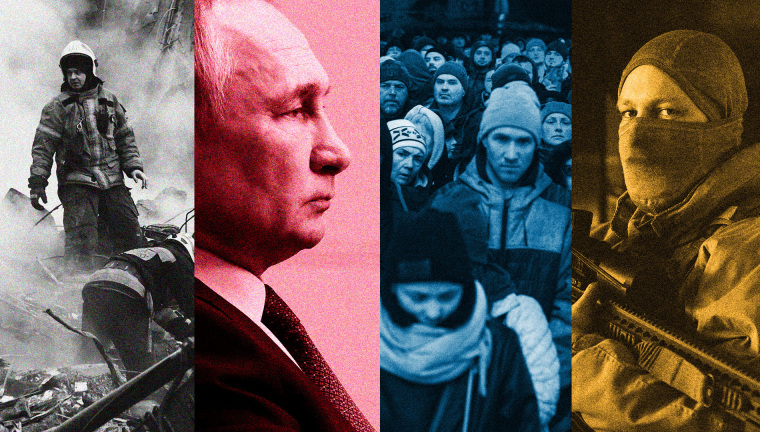Only future generations looking through the lens of history will know the true effects and human cost of the Russia-Ukraine war, Europe’s biggest land conflict since World War II.
For now, as we reach the first anniversary of President Vladimir Putin’s invasion of Ukraine on Friday, we can report on the stories of those trapped, killed or transformed by the war and highlight the numbers that illustrate its intensity and scale.
So far 100,000 Russian and 13,000 Ukrainian service personnel have been killed, according to Western leaders and Ukraine’s armed forces. And more than 7,000 Ukrainian civilians have died in the last year as a result of war, including at least 400 children.
Given the sheer number of missiles and drone attacks being launched every day, the true figure is almost certainly much higher on both sides.
Russia is firing about 20,000 artillery rounds a day, while Ukraine is firing 4,000 to 7,000 rounds daily, a senior U.S. official told NBC News in November.
None of those figures include the human toll since 2014, when a grinding war of attrition began between Ukrainian forces and Russian-backed separatists in Ukraine’s eastern Luhansk and Donetsk provinces, known as the Donbas, in which more than 3,400 civilians died, according to the United Nations.
More than 8 million Ukrainians have left the country and not returned, the majority finding refuge in neighboring Poland and Romania, according to the U.N. — an exodus not seen on the continent since the 1940s.
Ukraine’s population was 41.9 million in 2020, excluding the Russian-occupied Crimean Peninsula, according to the Ukrainian government’s statistics service. That means about 19% of Ukraine’s prewar population, roughly the equivalent of the population of Washington state, have fled the country.
Russia has had its own mass migration as a result of the war.
At least 419,000 people fled the country in the first half of 2022, according to Russia’s Federal State Statistics Service, Rosstat, many of them traveling to former Soviet states that don’t require visa approval for Russians, such as Georgia. By contrast, in the first half of 2021 just 202,000 left the country.
Hit by this exodus and by Western sanctions, the Russian economy has nonetheless defied the worst predictions to allow many in the country to proceed with life as normal. However the effects of the war are biting beneath the surface.
More people fled after Putin mobilized 300,000 soldiers from Russia’s wide pool of reservists in September, such was the need for reinforcements to be sent to the front line. By the end of the year, the population had fallen by 555,332, from 146.98 million to 146.42 million, the state-owned news agency RIA Novosti reported.
High-security prisoners convicted of serious crimes were also recruited to fight in Ukraine by the Wagner Group, a private military company headed by Yevgeny Prigozhin, a longtime Putin ally.
As for the course of the war, momentum has shifted wildly.
Before the invasion, Russia controlled about 16,000 square miles of Ukraine, which rose to 62,000 square miles, about 27% of the country’s landmass, in the weeks after the invasion began on Feb. 24, according to charts from the Institute of the Study of War, a Washington-based think tank.
But in a spirited counteroffensive in the second half of 2022, Ukraine took back almost 29,000 square miles by November, including the key southern city of Kherson. That left Russia in control of about 18% of the country.
Russia is now engaged in a new offensive in the Donbas region, hoping to take and hold Donetsk and Luhansk and execute a plan Russian military leaders announced in April after having retreated from a failed attempt to take Ukraine’s capital, Kyiv, and other key cities in the west and the north.
Ukraine's fierce defensive stand has been made possible by arms, financial aid and training from the U.S. and other Western allies. Though strains have been evident in the alliance and Ukraine may fear it might not count on such support indefinitely, President Joe Biden's surprise Kyiv visit underlined the commitment from Washington to Warsaw.
After weeks of stalemate, it already looks like 2023 could bring some dynamic shifts on the battlefield in Ukraine.
Nevertheless, many military experts have cautioned that there is no end in sight for a war that could last many more years.


